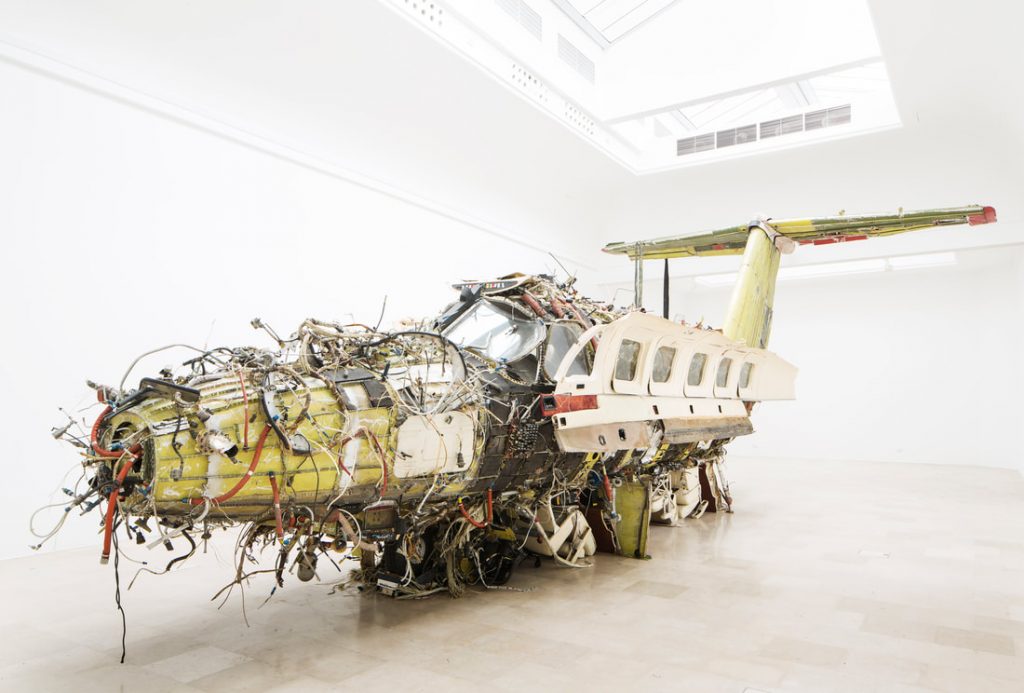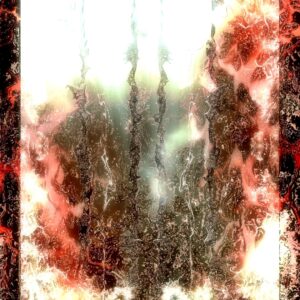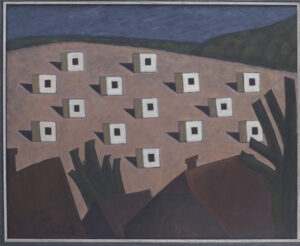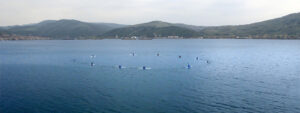May You Live In Interesting Times, 58th Venice Biennale 2019
There is a clear resistance to a more polemical and didactic use of art in Ralph Rugoff’s curatorship of the 2019 Venice Biennale. When the curator distinguishes art from the “texture of facts” of journalism or historical reportage, one can’t help but see it as an implicit critique of the documentary and archive-heavy 2017 Documenta 14. There is instead a faith in form, with artworks not being reducible to being ‘about’ a particular issue or subject. But that does not mean the biennale does not address issues— forms open out to particular reflections on our crisis-ridden present. Rugoff wants both his cake and to eat it. The split format in which we see two “propositions” by the same artists across both the Giardini’s Central Pavilion and the Arsenale, proceeds from the idea of multivalency, that the 79 artists themselves are not contained by single works nor their art limited to a single reading, but different aspects of their work possess potential for multiple interpretations when experienced in different contexts and in relation to the work of other artists. Art is seen in terms of complexity, ambiguity, contradiction, and a point of departure rather than a conclusion. There is a re-evocation of Umberto Eco’s 1960s concept of the “open work”.
The formal emphasis shifts away from the overt didacticism and overdetermined nature of many recent festivals, in which the art seemed to serve a box-ticking exercise for the curator’s particular agenda. Film and photography with their documentary potential are as a result not as dominant, and painting and sculpture are abundantly present.
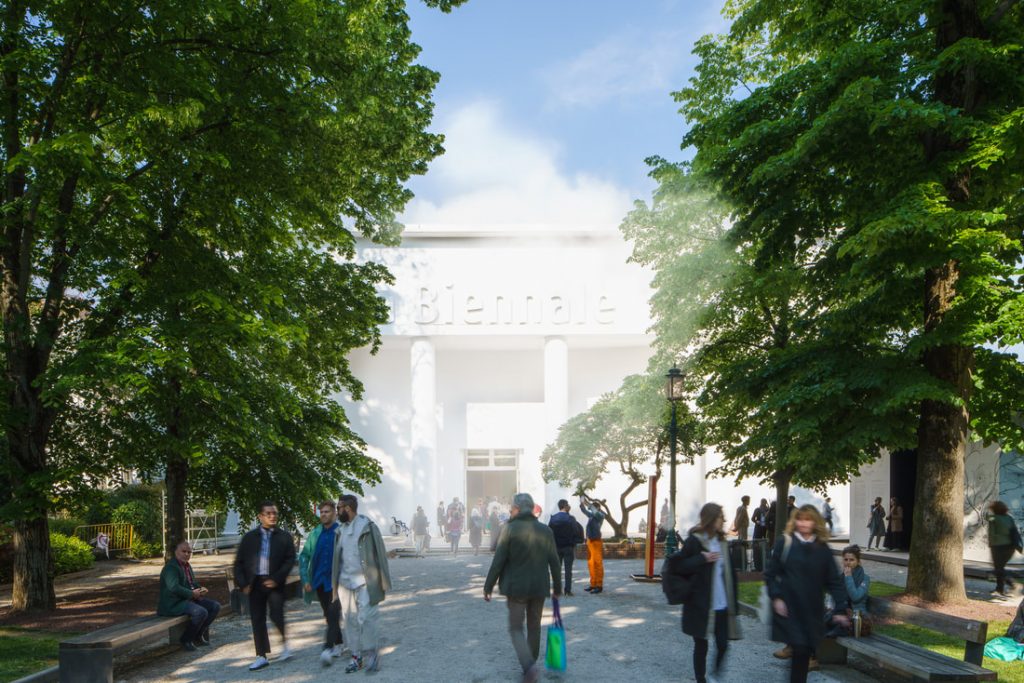
Lara Favaretto, ‘Thinking Head’, 2018. 58. Esposizione Internazionale d’Arte – La Biennale di Venezia, May You Live In Interesting Times. Photo by: Andrea Avezzù. Courtesy: La Biennale di Venezia.
As if a scene-setting exercise for the Biennale’s narrative, the architecture of the front of the Central Pavilion is bathed in mists. Lara Favaretto’s cinematic special effects provide an apposite theatrical cue to the evasiveness and poetics of the whole Biennale assembly. This romantic fog serve also as a foil to the sinister connotations of smoke billowing from the Fridericianum tower created for the last Documenta by Daniel Knorr.
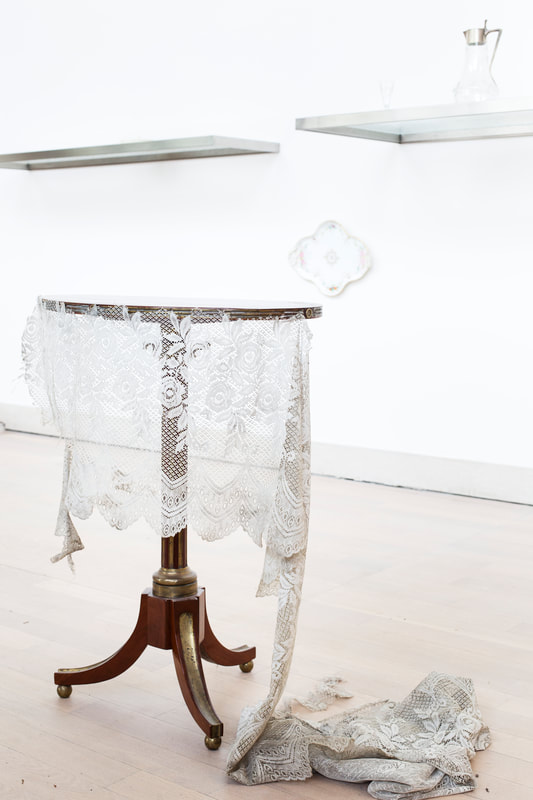
Cathy Wilkes, British Pavilion, 2019. Mixed media. 58. Esposizione Internazionale d’Arte – La Biennale di Venezia, May You Live In Interesting Times. Photo by: Francesco Galli. Courtesy: La Biennale di Venezia.
Judging by the queues, the two most popular pavilions during the opening few days were those of Britain and France. Both shows also sit comfortably within the frame of Rugoff’s curatorial thesis. Cathy Wilkes’ meticulously restrained installation haunts the British pavilion. Cued by a cryptic and impenetrable artist’s statement, the pared down installation accents absence, silence and non-space, still life melancholy. Displaced ornaments, half-erased paintings, dead insects, blank pages and dried flowers are suspended on and around a large muslin covered, floor-based rectangular structure, the centrality of which within the installation suggests significance, but the form’s status or function is unclear. Is it a bed, a plinth or a fragile enclosure? Is the exterior surface of this object meant to hold our attention or are we invited to look beyond the translucent muslin and consider the structure’s interior space as a metaphor for subtle containment? Such liminality, with the implied flux and change between interior and exterior states, insinuated by the appropriated and modified objects, pervades the whole of Wilkes’ exhibition, and suggest a psychological dimension, where objects borrowed from a shared public culture appear saturated with private melancholic resonance. Among the bric-a-brac objects that look inherited from someone else’s life, swollen bellied figurative forms punctuate the first room, sentinel like. But how do we read these distended figures, barren or malnourished, or fertile or gluttonous? Ambiguity typifies the work and while such reticence does induce close scrutiny of the individual artefacts, and speculation on the nature of the articulation between them, the nature of any relationship remains frustratingly unclear. The fastidious placement of the objects, such as washbasins and ornaments within the pavilion, register a highly controlled domesticity, and disquieting social containment. It is difficult to place these elegiac objects historically, they hearken back to another time and another place, all one can say is that they seem not of today, and out of joint with the contemporary world beyond the Pavilion’s walls.
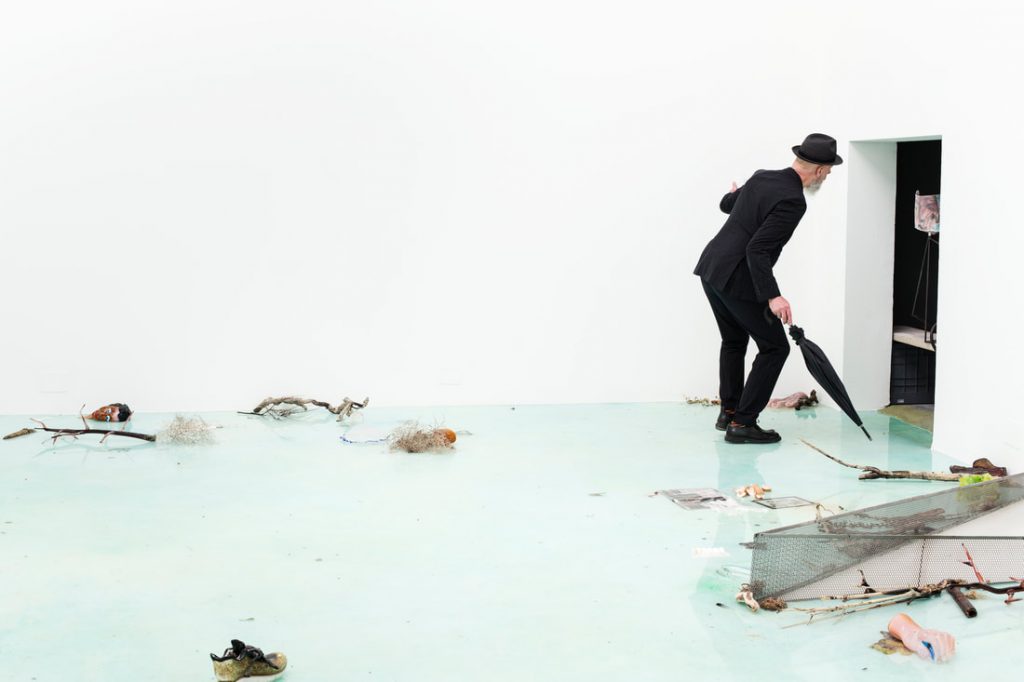
Laure Prouvost, ‘Deep see blue surrounding you / Vois ce bleu profond te fondre’, 2019. Single channel video projection, colour, sound. Pavilion of France. 58. Esposizione Internazionale d’Arte – La Biennale di Venezia, May You Live In Interesting Times. Photo by: Francesco Galli. Courtesy: La Biennale di Venezia.
The relationship to this ‘outside’ is a theme specifically addressed in Laure Prouvost’s adjacent exhibition housed in the French Pavilion. In her hectic film, installation and performance, Deep See Blue Surrounding You/ Vois Ce Bleu Profond Te Fondre, Prouvost floods the French Pavilion with a continuous flux of found material intermingling and mutating into new forms. Adopting the “open” road movie format she takes the viewer on a journey, the mobility of these works exemplified by the metaphor of liquidity. With Prouvost’s art, boundaries are blurred, even characters appearing in her film are periodically present in the space— artwork and actuality crossover. Her project is all about connections, beginning with the viewer’s own journey, entering from the rear and earth-filled basement of the pavilion, where there appears to be the start of a tunnel, we ascend into a glassy installation, awash with aquatic matter and litter, sea creatures, plastics and old mobile phones. In Prouvost’s film we witness a joyous stream of consciousness as we follow characters journeying from Paris to Venice, in which there is the constant assertion of identities blurring, all against the clearly segregated borders that mark our present.
Prouvost’s fluid metaphor characterises many works in the Arsenale and Giardini. To cite a few examples: Zanele Muholi’s destabilizing of identity through self-portraits, the uncanny use of male dummies by the artist Martine Gutierrez, who photographs herself erotically entangled with them, Mari Katayama who fashions and extends her self through figurative prostheses, the vitrines of woollen reefs by Christine and Margaret Wertheim, Antoine Catala’s animate panels that inflate and deflate, the constant movement of the machines by Sun Yuan and Peng Yu, and Shilpa Gupta’s gate that eats into the Central Pavilion’s structure, or just the blinding interruption of light in Ryoji Ikeda’s reflective walkway. We are very much in the realm of the senses. The labels that were avidly photographed during the press preview offer their predictable containment, but in this Bienniale we did not have walls of text and endless rows of archival documents or long documentary films to endure.
The Canadian Pavilion features the artist collective and Canada’s first Inuit production company, Isuma’s One Day in the Life of Noah Piugattuk, a powerful filmic re-enactment of the 1961 removal of an Inuit family from Baffin Island. It is a study of language and gestures and performance, the grandeur of the history of erasure and colonial subjugation played out through the close-up intimacy of details, and the slowness, through the act of translation and the resistance articulated through Noah’s impassivity. This is not anthropological. It raises documentary as a problem and counters it with its own moving realistic theatre.

Arthur Jafa, ‘The White Album’, 2019. Single channel video projection, colour, sound. 58. Esposizione Internazionale d’Arte – La Biennale di Venezia, May You Live In Interesting Times. Photo by: Francesco Galli. Courtesy: La Biennale di Venezia.
Much of the film work opposes documentary. In the Giardini’s Central Pavilion, Golden Lion winner Arthur Jafa, presents his sardonically titled White Album, a 50-minute video discourse on race and power compiled from footage appropriated from mobile phones, music videos, documentaries and YouTube clips. Featuring chilling footage of white supremacists showing off their weaponry, or stuck in a neurotic, repetitive tirade of racist abuse towards a black police woman, juxtaposed alongside tender portraits of some of Jafa’s own white friends, the video projection re-presents, to what was at the time of our viewing a mainly white audience, the complexities, and terrifying capabilities of ‘whiteness’.
The film ASSEMBLY by Angelica Mesiti, in the Australian Pavilion, presents music, dance, poetry and gestures of street protest, against the court and state. This is one of many works at this year’s Bienniale featuring music as a prominent component in videos exploring social issues. Unfortunately, the potential for public engagement suggested by the work’s title is rendered literal and banal, a spectacle of participation as passive consumption, with the seated audience contained in the circular ‘agora’ around which the three-screened work is projected. Why the work takes the form of a three-screen projection seems to be determined more by the need to achieve a symmetry of presentation for the viewing audience than anything determined by the work’s narrative or aesthetic. The use of over-elaborate staging, a reliance on the seductive potential of music and the incorporation of dance, is a recurring tendency within a number of underdeveloped and underwhelming video works supposedly responding to a contemporary political situation. A case in point is vividly demonstrated in the Swiss Pavilion. In Pauline Boudry and Renate Lorenz’s Moving Backwards, choreography is generated by body movements, film loops and animated objects, which according to the accompanying Pavilion blurb, provides visitors with the opportunity to “participate in strange encounters, in an environment reminiscent of a nightclub.” A desultory sparkly curtain separating the seated audience from the large video projection serves as a meagre evocation of a nightclub and the choreography, featuring both actual and digitally mastered reversed movement, is apparently inspired by the account of a cunningly simple tactic deployed by female Kurdish fighters of wearing their shoes backwards to confound those tracking them in the snow. The video is an impoverished interpretation of the astute manipulation of representational codes performed by the fighters themselves. Despite the claims that the work is a response to “regressive and reactionary forces of closure towards the other and towards difference” the work fails to carry the political and critical punch the artists seek. The Brazilian Pavilion offered a much more effective and critically astute use of dance and performance, with Wagner and de Burca’s Swinguerra blurring documentary with theatre in their filmic presentation of sexualized sub-cultural urban dance music and routines, popular in north-east Brazil. The stereotypical sexual roles adopted in the performances are countered by the non-binary identities of the dancers.
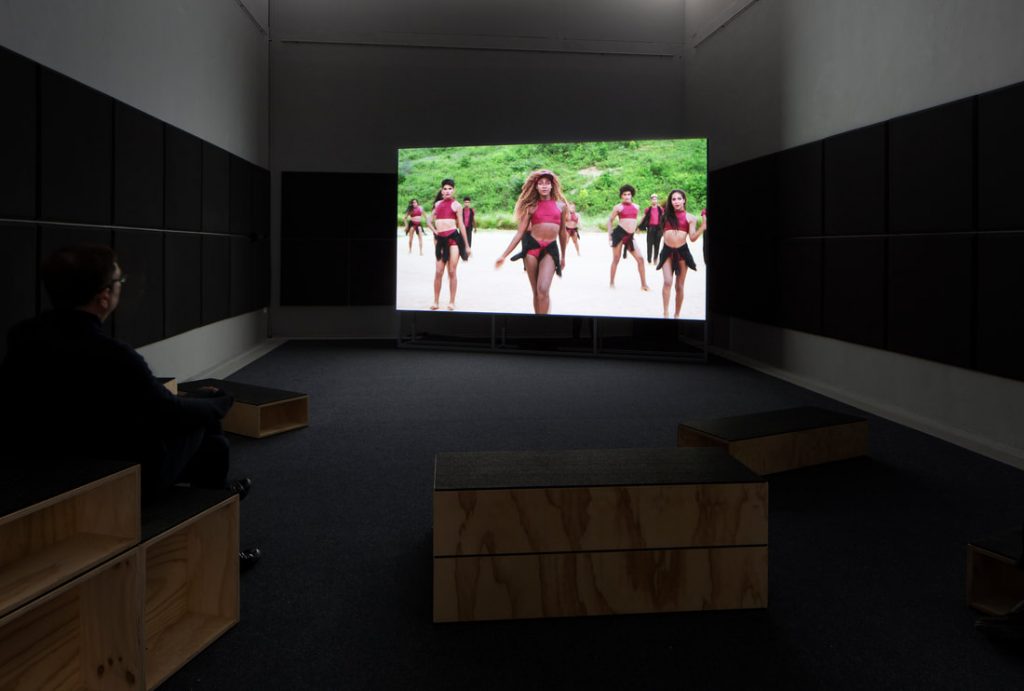
Pavilion of Brazil, ‘Swinguerra’, 2019. 58. Esposizione Internazionale d’Arte – La Biennale di Venezia, May You Live In Interesting Times. Photo by: Francesco Galli. Courtesy: La Biennale di Venezia.
While there is no Palestinian Pavilion in this Biennale, the Danish Pavilion hosts work by the Palestinian artist, Larissa Sansour. Her two-channel black and white film In Vitro uses the genre of science fiction to explore questions about belonging, heritage, survival and future world-building. Centred on the confrontation between two female scientists in a post-apocalyptic subterranean world, set beneath the destroyed city of Bethlehem— memories of the city for one, on her deathbed, become vital, while for the other, a clone, the only world she knows is underground. The film is accompanied by an installation, which involves the construction of a black sphere that features in the film as a repository of memories. Filling a darkened room, the large object is experienced as a black void, redolent of loss.
While there is no Palestinian Pavilion in this Biennale, the Danish Pavilion hosts work by the Palestinian artist, Larissa Sansour. Her two-channel black and white film In Vitro uses the genre of science fiction to explore questions about belonging, heritage, survival and future world-building. Centred on the confrontation between two female scientists in a post-apocalyptic subterranean world, set beneath the destroyed city of Bethlehem— memories of the city for one, on her deathbed, become vital, while for the other, a clone, the only world she knows is underground. The film is accompanied by an installation, which involves the construction of a black sphere that features in the film as a repository of memories. Filling a darkened room, the large object is experienced as a black void, redolent of loss.
For the Polish Pavilion, Roman Stańczak has gutted and flayed the fuselage of a private jet—selectively revealing its operational infrastructure, its network of exposed conduits bristle on the plane’s exterior. Such formal inversion is typical of Stańczak’s previous work, but due to its scale and context, this iteration is freighted with a range of apparently political connotations. In representing Poland, the work accrues potential meaning determined by national references, for some, the work reads as a visual metaphor for the journey and transformation of Polish society since the destruction of communism and the social division created by its embrace of capitalism. For others it references the plane crash in 2010 in which Poland’s then-President, Lech Kaczynski, and 95 government officials died, an event that far-right supporters of Poland’s ruling Law and Justice Party (PiS) continue to promote as a Russian plot. For others still, turning the jet inside out is to be seen as a gesture directed against the object’s status as a luxury commodity, one indicative of privileged mobility and wealth and replicated by the numerous super yachts moored by the Biennale. Such interpretative open-endedness typifies the way in which many works are positioned in this Biennale. On a smaller scale, among the artworks jostling for attention in the Central Pavilion, Alexandra Bircken presents a Ducati that has been cut in half. Accompanied by the display of racing leathers pinned to the wall like the skin of a trophy kill, the ‘masculinised’ targets of the attack are all too clear.
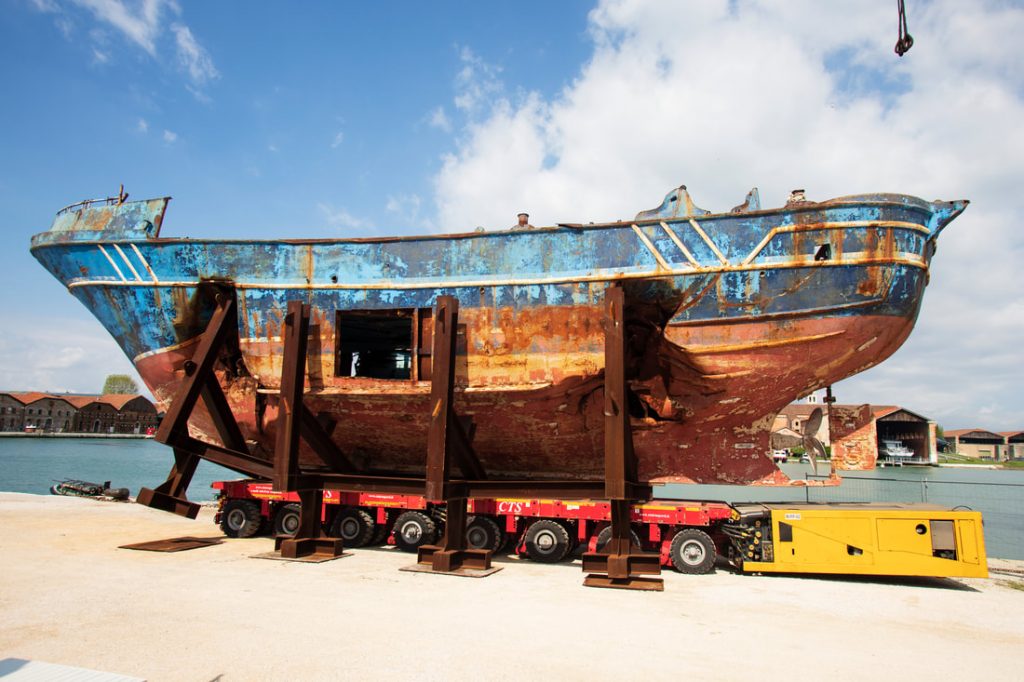
Christoph Büchel, ‘Barca Nostra’, 2018-2019. Shipreck 18th April 2015. 58. Esposizione Internazionale d’Arte – La Biennale di Venezia, May You Live In Interesting Times. Photo by: Italo Rondinella. Courtesy: La Biennale di Venezia.
Jimmie Durham’s heavy slab of marble, Black Serpentine, asks questions about the costs and point of the object’s display. A captioning text panel, informing us of its quarrying and transportation from India to Germany and finally Venice, brings a guilty conscience to our encounter with this minimalist form. Teresa Margolles trades upon the narco-violence of her home city, presenting in the Central Pavilion a twelve-meters cinder block wall, with bullet holes and topped with barbed wire, from the Mexican border city Ciudad Juárez. But this is spectacularly trumped by the shipwreck plonked in the former dockyard of the Arsenale, a fishing boat in which 700 to 1,100 migrants, many of them locked in the hull and machine room, lost their lives in April 2015, after it collided with a Portuguese freighter coming to its rescue. This death trap, tomb, graveyard, memorial, insensitively, and perhaps deliberately, located next to a refreshments stall, without any captioning, has generated a lot of fury and debate, which Christoph Büchel, the artist identified with its display, has said we are to see as part of the work. Salvaged by the Italian government in order to remove and identify the remains of the deceased in 2016, one could see its inclusion in the Biennale as a response to the former Italian Prime Minster, Matteo Renzi’s proposal of bringing the shipwreck to Brussels. For one of the hard-right anti-migrant politicians now in the Italian government, the boat is “propaganda”. Like Margolles’ wall, it is not ambiguous, it is a specific and historical object, no matter how out of context in its location of privileged leisure and cultural consumption. Evidence of one of the worst tragedies of global migration, it stalls interpretative freewheeling and cuts through the mists of vagueness pervading this Biennale.
David Campbell and Mark Durden
